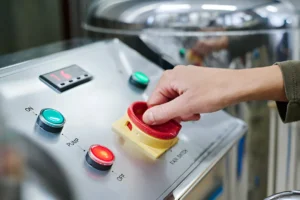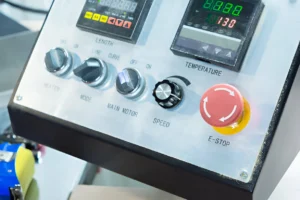What is a changeover switch, and how does it work? In this blog, we will break down the fundamentals of changeover switches, their types, and their applications. By the end, you’ll have a clear understanding of how these switches enhance electrical systems’ efficiency and safety.
What is a Changeover Switch and Why is it Important?
A changeover switch, also known as a Changeover Switch, is an electrical device used to switch a load between two sources. These switches are crucial in managing the continuity of power supply. They are commonly used in systems where it is essential to have a backup power source, such as generators or alternate power grids.
It’s important to install a Changeover Switch for a number of reasons. Firstly, it ensures that your generator is only supplying power to the circuits you choose, and not to the entire electrical grid, which can be dangerous. Secondly, it prevents electrical backfeeding, which can occur when the generator’s electrical supply is fed back into the utility company’s electrical grid, posing a serious safety hazard to utility workers.
How Does the Changeover Switch Work?
Source Selection
The transfer switch’s primary function is to select the power source for the connected load. This selection can occur between a primary power source, such as the main electrical grid, and a secondary source, like a generator.
1. Automatic Detection
In automatic Changeover Switchs, sensors constantly monitor the status of the primary power source. When a power failure or voltage drop is detected, the switch automatically initiates the transfer process.
2. Manual Operation
In manual Changeover Switchs, an operator must physically move the switch to change the power source. This requires an understanding of the system’s status and the readiness of the secondary power source.
Contact Mechanism
The contact mechanism within the transfer switch is crucial for establishing a reliable electrical connection.
1. Open Transition
Also known as break-before-make, where the switch breaks the connection with the primary source before making contact with the secondary source. This method ensures that the two power sources are never connected simultaneously, preventing potential electrical faults.
2. Closed Transition
Known as make-before-break, this method briefly connects both power sources to the load during the transfer. This approach provides a seamless transition with no interruption but requires both sources to be in perfect sync to avoid complications.
3. Contact Materials
The contacts within the switch are typically made from durable materials such as copper or silver alloys to ensure longevity and reliability under load conditions.
Seamless Transition
Ensuring a seamless transition between power sources is vital for systems requiring continuous operation, such as hospitals or data centers.
1. Synchronizing
In closed Changeover Switchs, synchronizing the frequency and phase of both power sources is essential to avoid electrical disturbances during the switch. Advanced automatic transfer switches use sophisticated control systems to manage this synchronization.
2. Minimal Interruption
For open Changeover Switchs, the goal is to minimize the time between breaking contact with the primary source and making contact with the secondary source. This is managed through fast-acting mechanisms and reliable control circuitry.
3. Backup Readiness
Ensuring the secondary power source, such as a generator, is always ready to take over. This involves regular maintenance and testing of the backup system to ensure it can handle the load immediately when required.


Types of Changeover Switch
Manual Changeover Switch
Manual Changeover Switches require human intervention to shift the electrical load from one power source to another.
1. Operation
- The user physically moves the switch to connect or disconnect the power sources. This method is straightforward and cost-effective.
2. Applications
- Typically used in residential settings and small commercial setups where power outages are infrequent.
3. Advantages
- Simple design and lower cost.
- Easy to install and maintain.
4. Disadvantages
- Requires a person to be present during a power outage.
Automatic Changeover Switch
Automatic transfer switches (ATS) detect power loss and automatically switch to a backup source without human intervention.
1. Operation
- Equipped with sensors that monitor the primary power source. Upon detecting a failure, the ATS automatically transfers the load to the secondary source.
2. Applications
- Used in critical facilities such as hospitals, data centers, and industrial plants where uninterrupted power is crucial.
3. Advantages
- Ensures continuous power supply without human intervention.
- Rapid response time minimizes downtime.
4. Disadvantages
- More expensive than manual switches.
- Requires regular maintenance and testing to ensure reliability.
Generator Changeover Switch
- Specifically designed for use with generators as the backup power source.
- Ensures a smooth transition from the main power supply to the generator during outages.
Magnetic Changeover Switch
- Utilizes magnetic forces to control the switching mechanism.
- Offers precise and reliable switching, commonly used in industrial applications.
The importance of installing the Changeover Switch correctly
Proper installation of the switch prevents electrical failure and ensures safety and compliance. It guarantees the reliable performance of the Changeover Switch, reduces downtime, and extends equipment life. Professional installation reduces wear, facilitates regular maintenance, and ensures user friendliness and system integration. Through professional installation and maintenance, the switch provides a stable and continuous power supply in a variety of applications.
The purpose of the Changeover Switch
Changeover Switches ensure a continuous power supply, protect electrical systems, improve system reliability, and support critical infrastructure. In homes, hospitals, data centers, factories, and commercial buildings, Changeover Switches provide seamless power switching to prevent overloads, reduce downtime, and ensure public safety and the proper operation of critical equipment.


FAQS
1.Can transfer switches be used with renewable energy?
Yes, the Changeover Switch can be used with renewable energy sources such as solar and wind. Smart transfer switches can manage the conversion of electricity between renewable energy sources and the grid, improving energy efficiency.
2.Can I install the switch myself?
It is recommended that professional electricians perform installation. Proper installation of the switch requires compliance with safety codes and standards, and professional installation can also ensure the validity of the equipment warranty.
3.How to choose the right transfer switch?
Choosing the right Changeover Switch should consider the system load requirements, choose manual or automatic transfer switches, and choose a brand that meets quality and certification standards.
4.What devices can I run with the switch?
Changeover Switches can run household appliances and lighting, support industrial machinery and equipment, and maintain the power supply for commercial facilities.
5.What is the difference between automatic transfer switch (ATS) and manual Changeover Switch?
The Automatic Transfer Switch (ATS) automatically switches power when a power failure is detected for critical applications. Manual switch requires manual power switching and is suitable for small systems.
In conclusion
Changeover Switchs ensure a reliable and continuous power supply by efficiently switching between power sources. They are essential for critical applications. Proper installation and maintenance are key to their effectiveness.
For more insights on power management solutions, contact us today.

